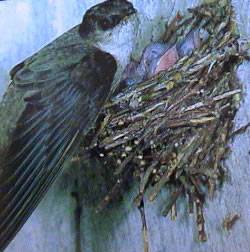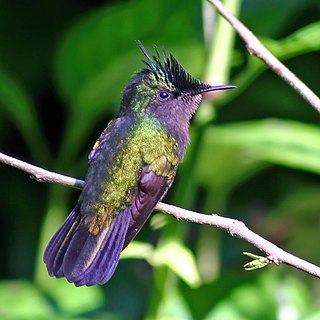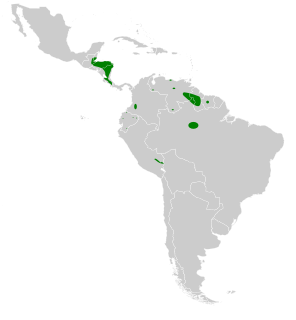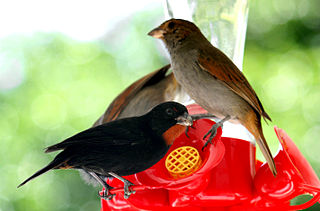
The band-rumped swift is a species of bird in subfamily Apodinae of the swift family Apodidae. It is found from Panama south through Colombia into Ecuador, east from Venezuela into the Guianas and Brazil, and on Trinidad.

The grey-rumped swift is a species of bird in subfamily Apodinae of the swift family Apodidae. It is found in Honduras, Nicaragua, Costa Rica, and Panama; in every mainland South American country except Chile, French Guiana, Suriname, and Uruguay; in Trinidad and Tobago; and on Grenada.

The Lesser Antillean iguana is a large arboreal lizard endemic to the Lesser Antilles. It is one of three species of lizard of the genus Iguana and is in severe decline due to habitat destruction, introduced feral predators, hunting, and hybridization with its introduced sister species, the green iguana. Successful captive breeding of this species has been limited to only two instances, as most captive-laid eggs tend to be infertile.

The chestnut-collared swift is a species of bird in subfamily Cypseloidinae of the swift family Apodidae. It is found from Mexico and Trinidad south to Peru and Bolivia..

Chaetura is a genus of needletail swifts found in the Americas. Although they resemble swallows, the two are not at all closely related; this is instead a result of convergent evolution. Some members of Chaetura are long-distance migrants, while others are year-round residents.

The Hispaniolan mango is a species of hummingbird in the subfamily Polytminae. It is endemic to the Caribbean island of Hispaniola.

The blue-headed hummingbird is a species of hummingbird in the "emeralds", tribe Trochilini of subfamily Trochilinae. It is found only on the islands of Dominica and Martinique in the Lesser Antilles.

The purple-throated carib is a species of hummingbird in the subfamily Polytminae. It is resident on most of the islands of the Lesser Antilles and has occurred as a vagrant both further north and south.

The Antillean crested hummingbird is a species of hummingbird in the family Trochilidae. Found across Anguilla, Antigua and Barbuda, Barbados, Dominica, Grenada, Guadeloupe, Martinique, Montserrat, north-east Puerto Rico, Saba, Saint-Barthélemy, Saint Kitts and Nevis, Saint Lucia, Saint Martin, Saint Vincent and the Grenadines, Sint Eustatius, the British Virgin Islands, the U.S. Virgin Islands, and the Lesser Antilles, while it has also been recorded as a vagrant in Florida, USA.

Chapman's swift is a species of bird in subfamily Apodinae of the swift family Apodidae. It is found in Bolivia, Brazil, Colombia, French Guiana, Guyana, Panama, Peru, Suriname, Trinidad, Venezuela, and possibly Ecuador.

The pale-rumped swift is a species of bird in subfamily Apodinae of the swift family Apodidae. It is found in Bolivia, Brazil, Colombia, Ecuador, and Peru.

The Costa Rican swift is a species of bird in subfamily Apodinae of the swift family Apodidae. It is found in Costa Rica and Panama.

The white-chinned swift is a species of swift in the family Apodidae. It is found from Mexico south through most Central America countries into South America as far south as Peru and east as far as Suriname.

The great dusky swift is a species of bird in subfamily Cypseloidinae of the swift family Apodidae.. It is found in Argentina, Brazil, Paraguay, and possibly Bolivia.

The brown trembler is a species of bird in the family Mimidae, the mockingbirds and thrashers. It is found on the islands of Saba, St. Kitts, Nevis, Montserrat, Guadeloupe, Dominica and St. Vincent in the Lesser Antilles of the Caribbean Sea.

The lesser Antillean bullfinch is a species of bird in the family Thraupidae. It is found in Saint Barth, Saint Martin, Anguilla, Antigua and Barbuda, Dominica, Grenada, Guadeloupe, Martinique, Montserrat, Netherlands Antilles, Saint Kitts and Nevis, Saint Lucia, Saint Vincent and the Grenadines, the British Virgin Islands, and the U.S. Virgin Islands.

The scaly-breasted thrasher is a species of bird in the family Mimidae. It is found throughout much of the Lesser Antilles of the Caribbean Sea.

The Lesser Antillean flycatcher is a species of bird in the family Tyrannidae. It is found in Barbuda, Dominica, Guadeloupe, Martinique, Saint Kitts and Nevis, and Saint Lucia. Its natural habitat is subtropical or tropical moist lowland forests.





















